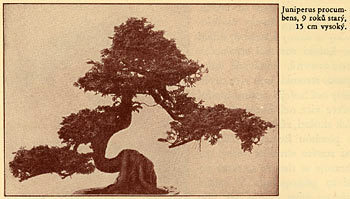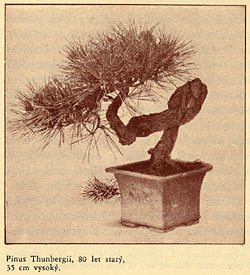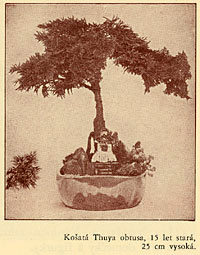|
The most arresting feature of miniature gardens, as they are spoken of in the previous article,
is the pigmy tree. In Europe these pigmies, though long ago known, came for the first time in large quantities for the great
exhibitions in Paris in 1889, when the Trocadéro park had the Japanese gardener
Kosavara. Then again they have not been given to much travel outside of Japan, and about six years ago,
appeared in larger quantities in Paris, which caused a real sensation, and then in 1927 there was a large
collection at the jubilee horticultural exhibition in Paris at the Cours la Reine.
Pigmy trees soon become "very fashionable" throughout Europe and now we see these among our garden plants. Japanese pigmies have always caught the attention of Europeans and already in 1826 the Dutch factory director Meylan acquired one of these wonderful creations of Japanese patience, which was in the container barely having an area of 7 cm2 with a height of 7 cm, the bamboo, flowering plum, and fir tree together thrived very well and he paid, curiously, about our current 16,000 CZK for this. If we wanted to be accurate, we would say, rather, that the cultivation of Japanese pigmies is not actually horticultural, but the refined torture of plants. It is hard to imagine the kind of immense patience which the Japanese gardener must spend to make a dwarf tree. How can we interpret the popularity of such trees? Dr. M. Kleinstück notes in this connection an interesting experience that Japan places a special value on each tree (also the wood, which is sometimes incredibly high prized), which shows a deviation from normal stature, or on wood which is different from what would normally be depicted in a painting or drawing. Such things arouse the enthusiasm of the Japanese, and even lead him to be brought into a trance, and a sense of bizarreness and asymmetry are encountered at every step. Therefore, the pine has become a popular and often zpodobovanym Japanese tree. The Japanese train trees of normal height, attach them to frameworks of bamboo poles and wires, and force the branches into unnatural positions. Often they also tie the various branches of trees together, the tree then forming a flat, talirovité crown. Young bamboo stalks tend to rise through the boards distorted, so the cross-section becomes quadrangular or triangular, etc.  Juniperus procumbens, 9 years old, 15 cm high These methods are further employed in the actual cultivation of pigmy or dwarf trees. The rules were set by the famous dwarf tree gardener Ito Magoyemon, which are followed to this day. Even the selection of seeds is done to deliberately achieve the desired result. Collected seeds are taken from the smallest specimens of the smallest plants grown. The plants, which are used, are searched for in shallow soils, in places exposed to the winds, in places with high humidity, or high, cold positions, briefly everywhere the natural conditions restrict the growth of the parent plants. Plants are grown in very tiny stoneware pots (the best material of this type is apparently imported from China). Plants are grown in soil containing fine sand and volcanic ash, or charcoal. The fact is that the plant is completely removed from the land, just surviving. The grower sees that this plant does not perish, then it prihnoji. Krsko must always have enough light, heat and humidity and also prihnojuji usually canola or other oil cake. Kleinstück considers that one of the main conditions for success is excess moisture. (The opposite claim is in the article by Prof. Tobiásek, who says that the plant is given just enough moisture to survive. It seems that there are different methods employed.) Substantial reduction in soil temperature is a result of evaporation and is relatively larger, the higher the ambient temperature (this is the purpose of having stoneware pots). This reduction in temperature, however, if possible, also restrains the growth of plants. An important role here, however, is the use of charcoal or volcanic ash, since it operates against rotting and avoids the consequence of excess soil moisture and still keep kysala fresh. This, so to speak, passive care, is treated as a second component of the process of active care. Growers restrict the growth of the plants' nakrucovánim, privazovánim and nalamovánim branches, and suppress the distorted roots, leaving only those which are necessary to keep the plants alive.  Pinus thunbergii, 80 years old, 35 cm high To reduce the direct increase in the height of trees, the trees are rotated several times around the principal strain axes, resulting in numerous strains on the nodes, such that zákrsku never nescházeji. Over time, as claimed by some authors, you can hold the plant in the reported limits of size. In flowering plants, however, this creates large and beautiful flowers. An especially prized quality then is for plants to be variegated, speckled or have white striped leaves, and even variegated leaves are another hobby of the Japanese gardener, who again has a penchant for everything bizarre. A French company ordered these wonders of the art of plant cultivation directly from Japan, and finished the whole group of miniature gardens, since they recently expanded their business into the Paris suburbs. However, since the demand for them has increased remarkably, we find today in Paris itself several specialists who deal with this artificial dwarfing. They then composed a lilliputian garden with their own material. To what has just been said, you may add some details for jimavymi which Prof. Tobiásek has in his interesting article, reproduced in the journal "Garden", Vol. XXIII. Examples are listed. The formation of trees is also helped by shading part of the plant so that the branches will bend toward the light. If the light reaches the branches and parts underneath, the upright growing tree grows horizontally. Since the lower part tree are illuminated more than the upper, the lower branches will grow over the top. Zkosati tree, but remains low with a flat crown. Where the old tree branch goes, it is replaced by the new branches prikopuluje. In March or April, as Prof. Tobiásek writes, the trees are transferred in Japan from the apartment to the garden, into a well-protected but open site (not under the shade of a landscape tree). The pots are set down into coarse sand and placed on shards so that excess water easily drains away. The trees remain this way during the summer. Once every 5-6 years the trees are transplanted, taking away the longest roots and adding fresh nutritious soil. However, the plant remains in the same pot. In winter the trees are kept in a bright but cool room.  Thuya Kosatá obtusa, 15 years old, 25 cm high Special care is devoted to sick plants. These are transplanted into the ground to allow free growth of new shoots which are protected from the sunlight. Particular care is paid to sick plants, which care has its origins in the superstition that the tree is connected with the fate of the family and, therefore, had it died, allegedly threatened the family's fortunes. Indeed, the superstition about the fate of a family connection with the tree is widespread in Japan and the habit of planting trees at the birth of children is widespread in Japan as it used to be in Europe. Besides, Prof. Tobiásek tells us that the formation of a random tree expressing the family chronicle can be read by a grower with a dedicated eye who knows how Krsko zákrsku to read it. With regard to the following types of cultivated trees and plants, we see between Pinus densiflora, Chamaecyparis, dwarf palm trees, Taxus, Ginkgo and a tiny species of fern, Davallia bullosa. Garden decorations complement bizarre rocks, houses and terracotta figurines. Japanese dwarf tree growers divide their creations into many categories. So-called "bonsai" are miniature trees which retain the natural habit, the name "Mikos" is given to trees with exposed bases, "kengai" refers to a different type of overhanging branches, while a tree shaped with the branches weeping, mournful, or zovou is a "nazashi." If the tree branches with pyramidal or conical symmetry, it's "jikki," if it has exposed stilt roots, it's "neagari." "Bukai" recalls the merger of a number of diverse liliputian trees in one container. The diverse distribution of European specialists, which first and foremost is Charles M. Weiss in Saint Cloud in Paris, recognize and classify their dwarf tree products into two groups: one in which the dimensions are reduced while keeping the overall growth habit, and second, where the form is subjected to intentional change. It is interesting that the earlier best subjects were vylicenym conifer. That is because of the slowness of their growth, smallness of their leaves and small demands for food. They are mainly: Chamaecyparis, and Pinus densiflora, Pinus parviflora, and Pinus thunbergi, some junipers, Juniperus procumbens (for example), larch (Larix), Podocarpus, Cedrus, and all of the Thuja. Other trees which may be dwarfed are some maples, e.g. Acer japonicum, an excellent addition and frequently available in a variety of leaves, the previously mentioned ornamental mume plum (Prunus mume), which can become full of white and pink flowers, some species of oaks, mainly Quercus dentata, which even in very small containers does not lose its life energy. The Planer Keaki rampart is a plantation and plant ivy. Japanese growers also grow some palm trees, such as Trachycarpus and Chamaerops, the Azalea indica, Cycas revoluta and certain types of bamboo grass, but they are no longer so easily subject to cruel Japanese dresure. 1 |